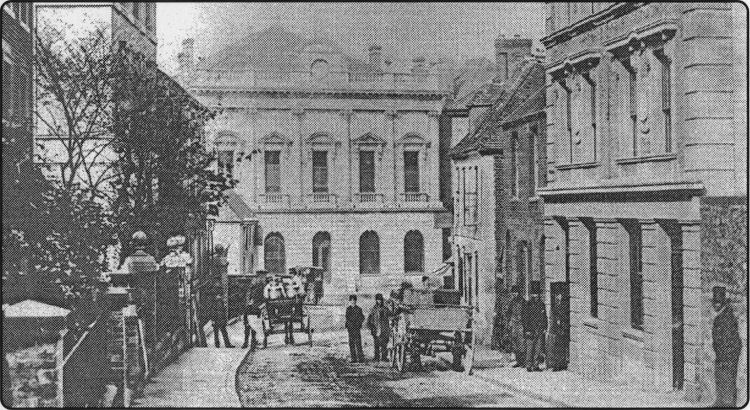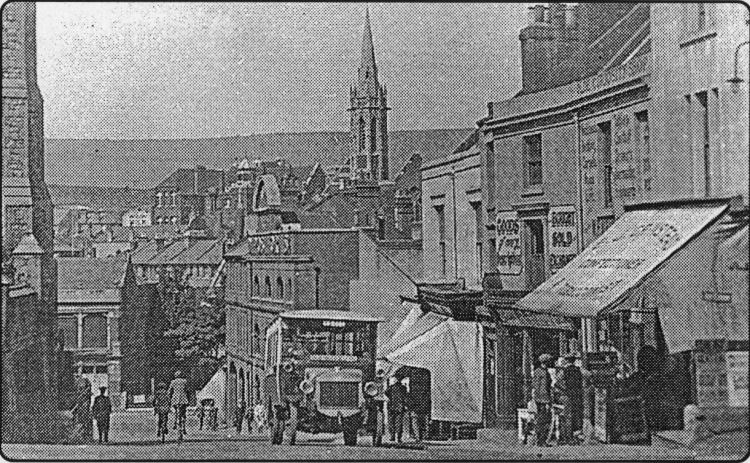
Published 26 September 2002


MODERN Folkestone owes its origins to the Victorian age but, sadly, many
buildings and other features which gave it so much character have vanished
altogether.
Changes in work and in ways of life have affected every corner of the town.
Some of those changes are vividly recalled in local historian Alan Taylor's
new book, Folkestone: Past and Present, a large format hardback book, now in
the shops.
Illustrating the dramatic changes that have taken place in a once modest
fishing port, part of an ongoing process in the town, the book is published
by Breedon Books, and is reasonably priced at £14.99.
The beautifully illustrated record recalls houses
and public buildings, local landmarks, shops, businesses and public houses
and other places of entertainment and leisure, that have vanished or been
altered almost beyond recognition.
The author, for whom the work was a labour of love, has been busy for months
matching up old views of the town with the much changed scene today, and
taking a series of photos to illustrate those changes from more or less the
same position from which the earlier scenes were recorded.
He takes the reader on a tour that shows the town during the era of early
photography, in the late 19th Century, and compares it with Folkestone of
today.
The book will be fascinating reading for everyone who is interested in
Folkestone's colourful past for, although only a small coastal village for
centuries, it was once an important Roman port and occupation by Saxons and
Jutes, all of whom must have appreciated its convenience as a staging post
to travel to the Continent.
Eanswythe, the daughter of Kent's King Eadbold, made the town her home back
in the 7th Century.
Alan recalls too the mid-Victorian period when the town was seen as a
flourishing and superior' resort created as a result of the vision and
influence of the major land owner in the
Photo record
district, the Earl of Radnor, and made possible by the coming of the railway
to the town and development of the harbour for the railway company's
cross-Channel steamers.
Since then the unrelenting process of change has been continuous and rapid -
fishermen's houses were demolished and districts were rebuilt in the 1930s.
the harbour and foreshore repeatedly redeveloped, while the lower end of
town was grievously damaged during two World Wars.
Changing scene
In more recent times, in the fifties and sixties, hotels and churches have
been pulled down or converted to other uses and whole networks of streets
- some part of the very character of the old town -have been greatly altered
or even obliterated.
Taking their place are modern bypass roads, over dominant blocks of offices
and flats - and car parks.
Many of those changes, which have transformed the town, are cleverly
demonstrated by Alan's choice of photographs for the book.
Chairman of the Folkestone and District Local
History Society, Alan was born and brought up in the town and has lived here
most of his life.
Following 22 years at sea as a ship's carpenter, he has concentrated on the
study of local history and that of Folkestone in particular.
Now retired he is author or co-author of several books, by different
publishers, culminating in Folkestone. Past and Present produced in
association with the KM newspaper group.
Those books include Sandgate in Old Picture Postcards, a pocket sized
hardback published several years ago by European Library, who have just
brought out a companion work. Book Two, with another fascinating collection
of pictures Sandgate selected and described by Alan Taylor.
In both his new books Alan acknowledges the help of fellow enthusiasts, who
have lent or shared information, the staff of the Heritage Room, at
Folkestone's public library and other helpers and writes of the invaluable
support of his family - wife Eileen and son Andrew.
Son Andrew assisted in writing introductions to both books and was closely
involved in proof read-ing and with technical support and advice.
BELOW: The lower end of Sandgate Road about 1866, looking towards the town
hall. The carts on the right may be delivering goods to the East Kent Arms.
Most of the properties on the left were still residential. BELOW left: The
view from Grace Hill down Dover Road in 1923 with an early bus climbing the
steep slope past a row of shops. These, like many other properties pictured,
have long since been demolished.
 |
Herald staff’s steam bus Hitsa5mph speed trap!
*i Q/\0 BELCHING steam, the "Progress." a .L5/vJfc24hp bus took 20
Folkestone Herald staff on an outing a century ago this month. A 7am
start was needed because the Progress was geared to run at a mere 10
mph. The trip to Thanet was via Elham Valley, and Canterbury, where
Salter the driver was cautioned by a 'bobby' for 'speeding' at 5mph and
moved on by another man in blue when he stopped to fill up the steamer's
boiler with water from the Stour! Luckily he found a pond at Sturry!
Popular columnist "Felix" tells us the Progress was from the same maker
as the puni>-i ring steam bus "Pioneer" he rode in on a pioneering run
from Dovor to the village of St Margaret's. The party was met at Barham
by three cyclists of the Dover Observer newspaper who rodo over to join
them at the Duke of Cumberland public house for breakfast. Some of the
F.J. Parsons party named were the manager F.G. Greatwood, "Tiny" Tim,
linotype operator George Crampton, George Haywara, and veteran Tom Hunt.
At the Wheatsheaf, Ramsgate, their host for lunch was former printing
staff colleague, Straughan.
|
Dancing girls not quite as the customers expected!
a af/jTHERE were catcalls from a disap-pointed faction in tho audience
and a walk-out during a performance at the Leas Cliff Hall 50 years ago
of "La Ronde Parisienne." It was advertised as a "sparkling Continental
revue" which evidently attracted some punters among the 900-strong
audience who had been expecting quite a different show to that
presented. Walk-outs began before the interval and there were noisy
interruptions and catcalls from a section of the audience in the
balcony. But the show went on as a steady drift of people made for the
exits. Some had expected a stage version of the famous French film La
Ronde. A number of people demanded and got their money back. The deputy
mayor, who was present, tola the Herald afterwards that the word
Parisienne had caused a young faction in the audience to expect to see
some "half-naked girls dancing." But a large number of the audience had
enjoyed the show, which had received good London press notices. Tho
Bishop of Croydon dedicated the new church of St Hugh of Lincoln at
Hawkinge WRAF Station 25 years ago. Organ, glass and furnishings were
donated by Lord Sherwood, owner of an earlier private chapel.
|
Record-bid Lympne flight ends abruptly in disaster
■f QQ*7 A SUJKlI bid to set up a record for a i long distance flight by
a light aero plane ended in disaster at Lympne. 75 years ago. Flight
officer R.L. Ragg, of the RAF crashed his Hawker Cygnet on take-off as
he set out to make a non-stop flight of 1,200 miles to Bucharest. From
the start there were ominous signs of likely failure, as the pilot
struggled to get airborne. And, when he did, he failed to gain enough
height to clear nearby telegraph poles, struck the wires and nose-dived
to the ground, miraculously escaping death. The machine was completely
wrecked but did not catch fire and the pilot emerged from the aircraft
without injury. The conclusion was the weight of aviation fuel being
carried for the long flight was too much for the ongine. The year
before, flown in turn by the same pilot and a brother officer, the
aircraft had come second in a light aircraft competition at Lympne,
winning a £1,500 prize. Silver Queen Motor Service, which garaged
coaches at an airship station at Capel, ran Friday to Monday trips from
Folkestone to Ostend with coach runs to Ypres. and to Bruges and
Holland. The cost: under £3.50!
|
Ban disco drink - or there will be tragedy says judge
<| Q77A DRAMATIC warning was given by a Jmtj I I Judge at Maidstone
Crown Court during the trial of 10 youths involved in a violent punch-up
after a visit to a Folkestone disco 25 years ago. There was an affray
outside the disco and some were involved in a fight in Hawkinge. The
Judge, who had dealt with another case involving the same disco several
months before, warned that booze should be banned at the disco before
someone was killed. The drinks licence he said should be revoked and tho
police should "take more interest in what went on" at the disco. But the
disco rranagur told the Herald the judge was talking "absolute rubbish,"
and didn't know what he was talking about. He kept a "tight ship" at the
disco and anyone even slightly inebriated was asked to leave and given
their money back. Some of those charged, he said, came from a well known
mining village and he described them as "real bandits" who came looking
for trouble. Some had been banned. Two youths, not local, were jailed,
two were fined £200 apiece and six others were each fined £100.
Youngsters were using a cul de sac at Payer's Park car park for
skateboarding while the Council debated how to rcuulate the pastime. |
|



